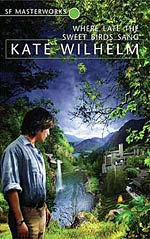
![]() Grayman14
Grayman14
9/24/2016
![]()
"I'm going to dissect your every thought, your every wish, every dream. I'm going to find out what happened to you, what made you separate yourself from your sisters, what made you decide to become an individual, and when I find out we'll know how never to allow it to happen again." (p.122)
The story begins as civilization is on the verge of collapse. The causes, pollution, disease and climate change, are briefly touched on by the author but she keeps them in the background. Instead, her focus falls on one extended family, the Sumners, and their attempts to survive. They have wealth and education on their side. Their isolated setting near the Appalachian Mountains of Virginia shields them from the worst of the global meltdown until a problem develops with their livestock. They are found to be infertile. When this infertility spreads to the people, the end really does seem nigh. Facing extinction, some of the survivors begin experiments in cloning, first on animals then later on themselves.
Kate Wilhelm's dystopian novel on cloning won both the Hugo and Locus Awards for Best Novel in 1977. The title of the book is a quotation from William Shakespeare's Sonnet 73. This sonnet focuses on the theme of old age:
That time of year thou mayst in me behold
When yellow leaves, or none, or few, do hang
Upon those boughs which shake against the cold,
Bare ruin'd choirs, where late the sweet birds sang
(The first four lines of Sonnet 73)
As well as growth and ageing, Where Late the Sweet Birds Sang is also a book about nature, both human and environmental. The landscape plays a significant part in the story, beginning with the pastoral setting which is brought to life by Wilhelm's vivid, descriptive prose:
'The river was high with spring runoffs up north and heavy March rains, [...] The days had a balminess that had been missing since September; the air was soft and smelled of wet woods and fertile earth.' (p.63)
'Apples hung red and heavy on the trees, and the maples blazed like torches against endless blue skies. Sycamores and birches burned gold, [...] Each blade of grass was edged in frost; it gleamed and glistened until it was melted by the rising sun.' (p.103)
A singular atmosphere is built in which a mixture of nostalgia - a bittersweet longing for simpler times - and eeriness can be felt. The nostalgia is evident in the descriptions of the landscape; the eeriness comes from the clones.
'He stared at their smooth young faces; so familiar, living memories every one of them, like walking through his own past, seeing his aged and aging cousins rejuvenated, but rejuvenated with something missing. Familiar and alien, known and unknowable.' (p.56)
The first generation of clones are physically identical copies of the donors, but there is something different about them psychologically. Wilhelm creates an unsettling otherness in the scenes with the cloned brothers and sisters. As time passes, they appear to develop a kind of collective consciousness or empathy, preferring to stay close to each other as a group. Individuality is frowned upon, as can be seen in the quote at the start of this review.
The book is split into three parts, and Wilhelm tells the story through three generations. She uses a different character as a focalizer in each part, and keeps the narrative character-driven. This technique helps to create a very human story, with any science remaining firmly in the background. For some reviewers this is a point of criticism. If you prefer your science fiction to be heavy on the science, then this book may not be for you. Contrarily, if you are looking for a thought-provoking take on the survival of the human race, rich in atmosphere and emotion, which asks questions about the collective versus the individual, then Where Late the Sweet Birds Sang comes highly recommended.
https://biginjapangrayman.wordpress.com/2016/09/22/where-late-the-sweet-birds-sang-1976-by-kate-wilh